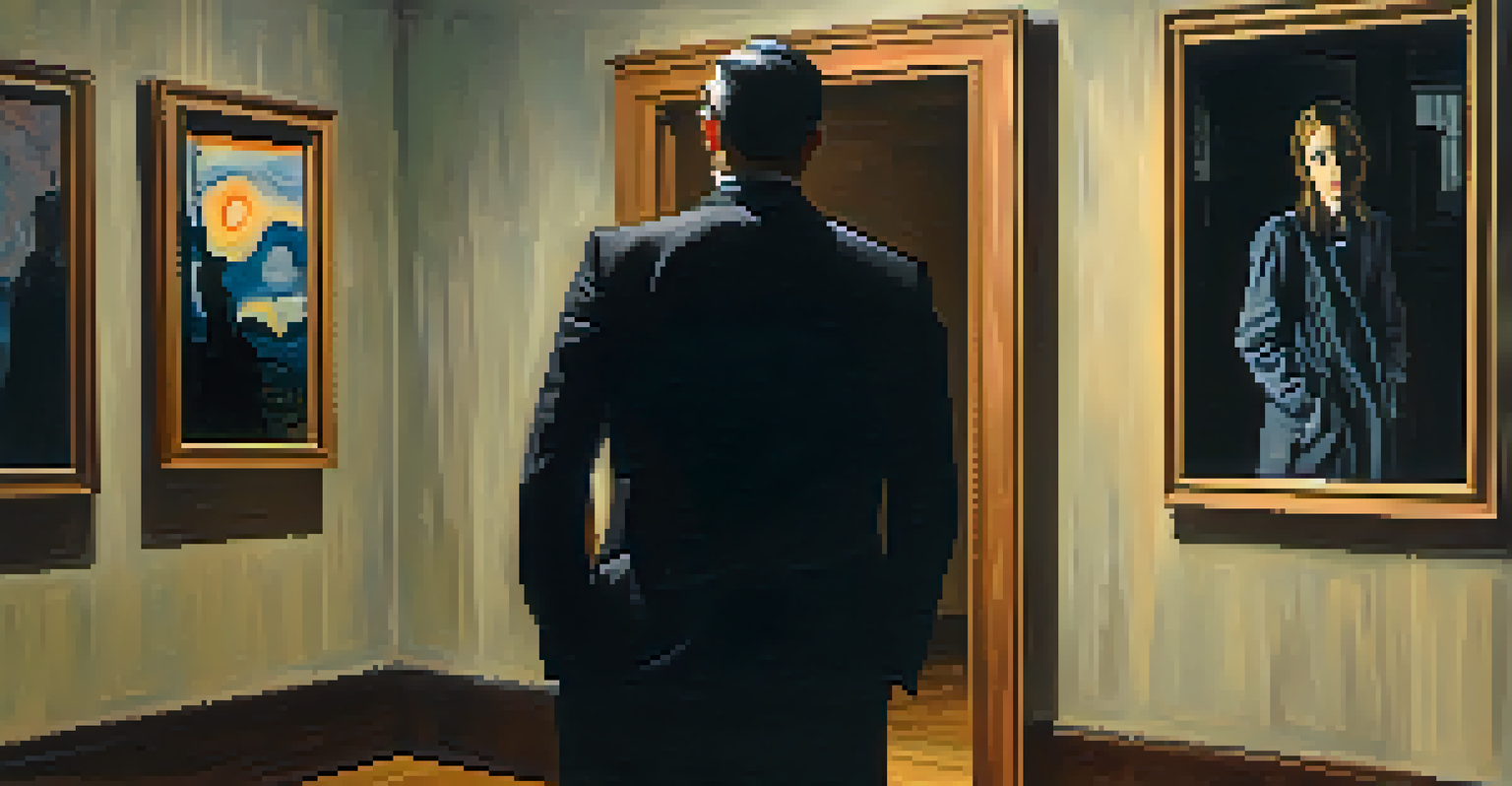The Use of Paintings as Metaphors in Popular Novels

The Power of Visual Imagery in Literature
Paintings have long served as powerful symbols in literature, transcending mere description to evoke deeper meanings. When an author references a painting, it often acts as a window into a character's psyche or the broader themes of the story. For instance, think of how a serene landscape painting can symbolize peace or tranquility, setting the tone for a character's emotional journey.
A picture is worth a thousand words.
Moreover, the visual nature of paintings allows readers to engage their imagination more fully. This engagement transforms reading from a passive activity into an interactive experience where readers interpret layers of meaning. As readers visualize these works of art, they create personal connections with the narrative, enhancing their overall experience.
Ultimately, the interplay between literature and visual art creates a rich tapestry of meaning. By integrating paintings into their narratives, authors invite readers to explore not only the text but also the emotions and ideas represented in these artworks, enriching the story's impact.
Iconic Paintings and Their Literary Roles
Certain paintings have become iconic due to their frequent appearances in literature. Take, for example, Edvard Munch's 'The Scream,' which captures existential dread and emotional turmoil. In novels, such imagery can mirror a character's internal conflict, making the painting a potent metaphor for their struggles.

Authors often choose specific artworks that resonate with their themes, creating a bridge between visual and textual storytelling. This connection can deepen readers' understanding of complex emotions or societal issues. For instance, a novel may reference 'The Persistence of Memory' by Salvador Dalí to explore themes of time and memory, offering a visual representation that complements the narrative.
Visual Art Deepens Literary Meaning
Integrating paintings in narratives enriches the emotional and thematic layers of the story.
By incorporating these well-known paintings, writers tap into a shared cultural lexicon, allowing readers to draw upon their familiarity with the artworks. This shared knowledge not only enriches the reading experience but also fosters a deeper dialogue between the text and the visual arts.
Paintings Reflecting Character Development
In many popular novels, paintings serve as reflections of character development. As characters evolve throughout the story, the artworks they interact with often mirror their transformations. For example, a character might initially view a chaotic painting with fear, only to embrace its complexity after undergoing personal growth.
Art enables us to find ourselves and lose ourselves at the same time.
This relationship between characters and paintings can create powerful moments of revelation. When a character stands before a painting, it can act as a catalyst for introspection, prompting them to confront their fears or desires. This metaphorical relationship enhances the narrative by providing insight into what drives the character's actions.
Thus, paintings become more than just decorative elements; they are integral to character arcs, symbolizing emotional milestones. By intertwining visual art with character journeys, authors create a dynamic interplay that resonates deeply with readers.
Symbolism of Paintings in Thematic Exploration
The use of paintings in literature often serves to explore broader themes within a narrative. For example, a dark and moody painting might symbolize the theme of despair in a novel that tackles mental health issues, enabling readers to grasp the gravity of the characters' struggles. This symbolic use of art provides a visual shorthand for complex themes.
By embedding these visual metaphors into the story, authors invite readers to engage with the themes on a more profound level. The painting becomes a focal point for discussions about identity, society, and human experience. In this way, the artwork enhances the narrative's depth and invites critical thinking.
Art Reflects Character Growth
Paintings can symbolize characters' transformations, serving as catalysts for their personal revelations.
Additionally, this thematic exploration through paintings allows for diverse interpretations. Each reader may perceive the artwork differently, leading to various insights and discussions about the novel's core messages, making the reading experience richer.
Cultural Context and Paintings in Novels
The cultural context in which a painting was created can add layers of meaning when referenced in novels. For instance, a novel set in the Renaissance might reference works by artists like Leonardo da Vinci, whose art reflects the era's values. This context not only enriches the narrative but also educates readers about historical perspectives.
Authors often use paintings to highlight cultural contrasts or to comment on societal issues. A modern character contemplating a classic painting can symbolize the tension between tradition and contemporary values. This dynamic invites readers to reflect on how cultural legacies shape identities and relationships.
By weaving cultural insights into their narratives through paintings, authors create a bridge between past and present, allowing readers to understand how history influences contemporary life. This interplay enriches character experiences and deepens thematic explorations.
The Emotional Resonance of Art in Storytelling
Art evokes emotion, and its presence in literature can amplify the emotional resonance of a story. A painting that captures joy or sorrow can echo a character’s emotional state, creating an immediate connection with readers. This emotional layering allows readers to empathize more deeply with the characters' experiences.
For instance, a character may find solace in a vibrant landscape painting during a moment of despair, illustrating how art can serve as a refuge. This relationship highlights the therapeutic potential of art, emphasizing its role in healing and self-discovery within the narrative.
Cultural Context Enhances Interpretation
Referencing historical artworks adds depth to narratives, inviting readers to explore cultural legacies and their impact on identity.
As readers experience these emotional moments alongside the characters, the story becomes more impactful. The interplay between visual art and narrative not only enhances the emotional depth but also fosters a sense of shared humanity, reminding us of the universal nature of our feelings.
The Future of Paintings as Metaphors in Literature
As literature continues to evolve, the role of paintings as metaphors will likely expand and adapt. With the rise of digital art and multimedia storytelling, authors may explore new ways to integrate visual art into their narratives. This evolution promises to enrich the reading experience, offering fresh perspectives on the interplay between text and art.
Additionally, as society grapples with new themes and issues, the metaphors represented by paintings will also shift. For example, contemporary works that address climate change might find their way into novels, reflecting urgent societal conversations. This adaptability ensures that the metaphorical use of art remains relevant and engaging.

Ultimately, the future of paintings in literature is bright, as authors continue to innovate and explore the profound connections between visual art and storytelling. By embracing these possibilities, writers can create works that resonate with readers on multiple levels, fostering a deeper appreciation for both literature and art.